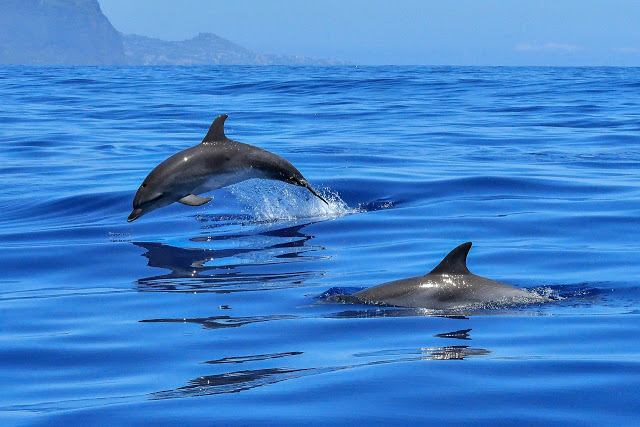
DOLPHINS ARE EXCELLENT NAPPERS.
Since dolphins can't inhale submerged, they have to swim up to the sea's surface to get air. So how would they rest without suffocating? Basically, dolphins are champion force nappers. As opposed to rest for a few hours one after another, they rest one half of the globe of their cerebrum for 15 to 20 minutes one after another, and they take these "snoozes" a few times every day. By resting each half of the globe of their cerebrum in turn, dolphins can keep swimming, breathing, and looking for predators every minute of every day.DOLPHINS COMMUNICATE WITH CLICKS AND WHISTLES.
Dolphins speak with each other submerged by making an assortment of vocalizations. To discover prey and explore the sea, they make clicking sounds, and they "talk" to different dolphins by whistling. Dolphins additionally produce boisterous burst-beat sounds when they feel energized or forceful, for example, when they have to frighten away a close by shark. Some female dolphins likewise produce a burst-heartbeat to censure their posterity, called calves, for awful behavior.In any case, DOLPHIN LANGUAGE REMAINS A MYSTERY.
Albeit sea life researchers have examined and recorded dolphin vocalizations for a considerable length of time, numerous parts of the creatures' language and how they impart are as yet obscure. Researchers have not yet separated the individual units of dolphin sounds, they're despite everything looking for a Rosetta Stone that connects the creatures' vocalizations to their behavior. By utilizing new innovations—including calculations and high-recurrence recorders that work submerged—researchers would like to at long last open the secret of the dolphin language.DOLPHINS MAKE FRIENDS WITH OTHER DOLPHINS.
Dolphins are exceptionally social, and researchers are as yet finding intriguing insights concerning how the amphibian well evolved creatures associate with each other. In 2015, researchers at Florida Atlantic University's Harbor Branch Oceanographic Institute distributed research in the Marine Mammal Science diary about the interpersonal organizations of dolphins. In the wake of going through more than six years following 200 bottlenose dolphins in Florida's Indian River Lagoon, the researchers found that dolphins have companions. Rather than investing equivalent energy with the dolphins around them, the creatures really isolate themselves into companion gatherings. Much the same as humans, dolphins appear to lean toward the organization of specific companions more than others.Every DOLPHIN RESPONDS TO ITS OWN NAME.
Dolphins aren't swimming around with unofficial IDs, however every dolphin has its own one of a kind whistle. Researchers accept that dolphins utilize these mark whistles forever, and female dolphins may even show their calves their whistles before they're conceived. Dolphins utilize their mark whistles to shout to each other and might have the option to recollect other dolphins' whistles after decades separated.THERE ARE 44 DIFFERENT DOLPHIN SPECIES.
Despite the fact that bottlenose dolphins are the most notable and unmistakable, there are 43 other dolphin species. Most species live in calm and tropical seas, yet a couple of live in colder seas or streams. Contingent upon their species, dolphins can differ significantly in their physical properties and behavior. For instance, the biggest dolphin species, the Orca (likewise called Killer Whale), can be 30 feet in length—multiple times longer than the littlest dolphins.FAMILY DELPHINIDAE, OCEANIC DOLPHINS
- Long-Beaked Common Dolphin, Delphinus capensis
- Short-Beaked Common Dolphin, Delphinus delphis
- Bottlenose Dolphin, Tursiops truncatus
- Indo-Pacific Bottlenose Dolphin, Tursiops aduncus
- Northern Rightwhale Dolphin, Lissodelphis borealis
- Southern Rightwhale Dolphin, Lissiodelphis peronii
- Tucuxi, Sotalia fluviatilis
- Costero, Sotalia guianensi
- Indo-Pacific Hump-backed Dolphin, Sousa chinensis
- Chinese White Dolphin (the Chinese variant), Sousa chinensis chinensis
- Atlantic Humpbacked Dolphin, Sousa teuszii
- Atlantic Spotted Dolphin, Stenella frontalis
- Clymene Dolphin, Stenella clymene
- Pantropical Spotted Dolphin, Stenella attenuata
- Spinner Dolphin, Stenella longirostris
- Striped Dolphin, Stenella coeruleoalba
- Rough-Toothed Dolphin, Steno bredanensis
- Chilean Dolphin, Cephalorhynchus eutropia
- Commerson’s Dolphin, Cephalorhynchus commersonii
- Heaviside’s Dolphin, Cephalorhynchus heavisidii
- Hector’s Dolphin, Cephalorhynchus hectori
- Risso’s Dolphin, Grampus griseus
- Fraser’s Dolphin, Lagenodelphis hosei
- Atlantic White-Sided Dolphin, Lagenorhynchus acutus
- Dusky Dolphin, Lagenorhynchus obscurus
- Hourglass Dolphin, Lagenorhynchus cruciger
- Pacific White-Sided Dolphin, Lagenorhynchus obliquidens
- Peale’s Dolphin, Lagenorhynchus australis
- White-Beaked Dolphin, Lagenorhynchus albirostris
- Australian Snubfin Dolphin, Orcaella heinsohni
- Irrawaddy Dolphin, Orcaella brevirostris
- Melon-headed Whale, Peponocephala electra
- Killer Whale (Orca), Orcinus orca
- Pygmy Killer Whale, Feresa attenuata
- False Killer Whale, Pseudorca crassidens
- Long-finned Pilot Whale, Globicephala melas
- Short-finned Pilot Whale, Globicephala macrorhynchus
- Guiana dolphin, Sotalia guianensis
RIVER DOLPHINS
- Boto (Amazon River Dolphin), Inia geoffrensis
- Chinese River Dolphin (Baiji), Lipotes vexillifer (considered functionally extinct)
- Ganges River Dolphin, Platanista gangetica gangetica and Indus River Dolphin, Platanista gangetica minor
- La Plata Dolphin (Franciscana), Pontoporia blainvillei
- Indus River Dolphin, Platanista gangetica minor




0 Comments:
Please do not enter any spam link in the comment box.